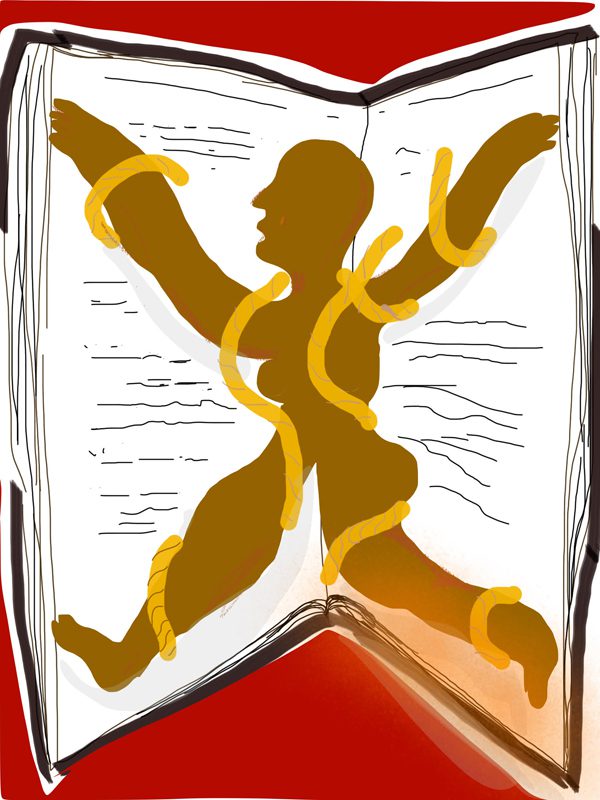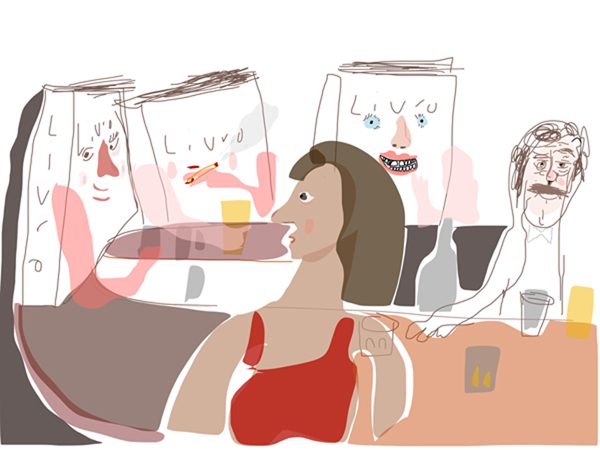
There’s evidence that D.H. Lawrence enjoyed an erotic power exchange relationship with his wife, that James Joyce was into scat (among other things), and that Oscar Wilde—well, most of us know what Oscar Wilde liked. These literary geniuses explored radical sexual agency and desire in their work and in their relationships, but little beyond rumors and personal letters exist to tell us what they themselves thought of their turn-ons and the ways in which those dovetailed with their writing. Even if space for such a discourse and community had existed back then, Lawrence, Joyce and Wilde couldn’t freely discuss their sexuality. As it was, they faced censorship and generated scandal wherever they went, and of course Wilde went to prison for his sexual behavior.
Although our world is still intolerant of sexual difference, I want to believe we’re at a point where people can speak openly about the consensual ways we express our erotic selves. And I’m interested in the connections between those private expressions and the larger, more public work we do in the world. This series is meant as a forging of community; a validation of that which gets called sexual deviance; and a proud celebration of the complex, fascinating ways that humans experience desire.
In this ongoing series of short personal essays, writers in all genres—novelists, poets, journalists, and more—explore the intersection between our literary lives and practices and our BDSM and fetishistic lives and practices. In other words, these essays aren’t about writing about non-normative sex: rather, it’s a series about how looking at the world through the lens of an alternative sexual orientation influences the modes and strategies with which one approaches one’s creative work.
If you have questions or comments, or if you’re a writer who would like to contribute, please contact me at kinkwriting@gmail.com.
–Arielle Greenberg, Series Editor
***
Bottom:Translator/Top:Text
When constrained, the only thing one can do is go deeper.
I do this because it’s hard, because it seems impossible, because I want to achieve the impossible, because I want to reach the limits and push beyond them. Because it hurts. Because when I get it right, I can fly. Volar. Fugarse.
Ha ha, the old joke goes; poetry is what is lost in translation. Everything is lost in translation—it’s the rote phrase used in just about every article anywhere that involves translation at all. Something lost. Something gained. And it’s true, I suppose, though I mean it differently than they do. Everything is lost in translation: you are lost in translation: I am lost in translation: we are all alone in translation. In the presence of the text I am alone before it, and all I can do is offer to serve it with my whole self, to the best of my ability. To contort myself and stretch myself and tie myself up in it. I am alone with the text: it is just me, and the text, and what it wants from me.
I am a literary translator. I translate poetry, graphic literature, and sometimes fiction, most often from Spanish into English. I have also translated and co-translated from languages I can’t read (still a somewhat controversial practice, despite it’s long history). I mostly translate traditionally (in a literary text, this means prioritizing meaning first, and then poetics) though I have translated experimentally (using erasure, homophonic, and other play-based practices). I translate from a source language and text into a target language. Literary translation, like BDSM, is the kind of practice that requires some explanation, because there are so many ways to do it.
 I am also a rope bottom. That means that I like to get tied up (and the person tying me up is a rope top, also called a rigger). There are other terms for a rope bottom—rope bunny, rope slut—but for the purposes of this essay I will call myself the bottom and the person tying me will be called the top. Bottom/translator; top/text. We could take rope figuratively and make it the text that I am translating. We could imagine the translator tied up in the lines of a poem, bound from every angle. We could imagine the silence of the bottom in that moment as the silence of the translator. We could imagine words pressing into the skin of the translator, leaving bites and burns, traces of its presence on the body of the translated text.
I am also a rope bottom. That means that I like to get tied up (and the person tying me up is a rope top, also called a rigger). There are other terms for a rope bottom—rope bunny, rope slut—but for the purposes of this essay I will call myself the bottom and the person tying me will be called the top. Bottom/translator; top/text. We could take rope figuratively and make it the text that I am translating. We could imagine the translator tied up in the lines of a poem, bound from every angle. We could imagine the silence of the bottom in that moment as the silence of the translator. We could imagine words pressing into the skin of the translator, leaving bites and burns, traces of its presence on the body of the translated text.
Rope and translation are similar, and not just on the level of metaphor. If translation is the closest I can get to a text, being in ropes is the closest I can get to myself. Translation makes the translator the closest reader of the text, the most knowledgeable scholar of the text, a position approximating author. The body through which the text comes to inhabit other languages. In rope everything that usually occupies my mind is cut away, and in the silence of my own mind and body I can fully inhabit myself. A kind of enforced meditation. The various personae I assume in my everyday life are shed and what is left is as close to a true self as I’ve ever known. Some call this subspace, this meditative, blissful encounter with silence and self.
Translation and rope are both places of paradox. I believe deeply in the importance of paradox for art, for life, and for a life that resembles art. I believe in complexity and contradiction. In allowing herself to become tied up in a text, the translator paradoxically gains her own creative freedom; the need to do whatever the text requires of her liberates her to create the text anew. In rope, where I am most limited is where I feel most free. Freedom. In translation, if everything is lost, then (paradoxically) it is where we are most free.
Another paradox of translation is that there both is and is not a right way to do it. Each translator has her own approach, her own reasoning, her own aesthetics and values informing every move. A translation is a series of complex choices, for which there are many possibilities. The intimacy between a translator and her text—between a bottom and her top—is one of navigating these possibilities to find the place where the movement within the binding lines is most true to the needs of them both. However, each translator is making only one of the possible choices, meaning that certitude is an impossibility. There is always another way to do it, because art and aesthetics are subjective. Necessarily, there must be many ways to translate the same text, because if the text is a work of art then it is open to possibility and to complexity of signification. There are also many ways to be in (rope) bondage: the variations are infinite and limited only by the imagination and physical capabilities of the rigger and the bottom. Each time you do a scene, it is different, and often different than what you expected going into it in wonderful surprising ways.
In translation, impossible is ground zero. There’s no way to translate a text so that all its complexities are made exactly equivalent in a new language. Likewise, in kink, the premise is that we’re all weird, so if we were to sit around judging each other’s weird, we’d end up alone pretty damn fast. Weird is ground zero. Many people in kink adopt a “not my thing, but if it’s your thing, go for it” mentality. A “so long as everyone is consenting, who am I to judge?” approach. This is something I’ve also found in the translation community. Homophonic translation? Not the way I work, but sounds interesting! Translating rhyming Petrarchan sonnets? Not my thing, but I can see why you might want to try it! There’s that same sense of we’re all doing this impossible, weird, slightly crazy thing anyway, so reserving judgment is in everyone’s best interests. Which of course is not the same as withholding legitimate critique and conversation.
More than “another way,” there is also a wrong way to do a translation, or at least there is in my subjective reasoning. If someone gets hurt, you’ve done it wrong. If someone (the text, the culture, the author, the translator) is hurt, and if you didn’t mean to inflict pain, then something is wrong. We are also talking, of course, about BDSM here.
How might an act of translation cause hurt? There is power at stake in every cultural creation. Who gets to write (the privilege of time and education). Who gets to be published. Who gets to be translated (hint: it’s disproportionally European men). But then there are power dynamics to consider in the act of translation, too. When you have a text from a non-dominant (i.e. colonized, oppressed, and subjugated violently and without consent) culture being translated into the language of the dominant culture (i.e. the colonizers), you have a power exchange. One that is (paradoxically) both non-consensual and necessary for any anti-colonial resistance. A language that represents cultural violence (as well as physical and economic violence) continues to do violence by appropriating and assimilating the texts of that culture. And taking culture as a body, translating a single (or even a dozen) texts from it as a kind of aesthetic dismemberment. A text contains not only itself, but also its allusions, its references (both artistic and cultural), its influence and its influences: extra-textual elements that native-language readers rarely consciously identify and that a reader from another culture will almost never be able to.
So there’s the violence of translation along traditional power dynamics. And it works in the other way too, when a text is translated from a dominant to a non-dominant language (for example, the Bible being translated into indigenous languages in order to convert and further entrench the colonization of Latin America). That is still a non-consensual act of cultural violence enacted upon the non-dominant language. But language itself is a tool, and can be used as a weapon. Language can be adapted, altered. Signifiers can be changed, have multiple and clandestine meanings.
As a submissive cis queer latinx woman, a rope bottom who is mostly topped by dom cis hetero white men, the surface of our power exchange looks extremely conforming. I offer my body to be tied by the people who already have power over it, systemic and cultural power. But submission can be empowering, being tied up can be freeing, these layers of possibility that power exchange contains, that make it so interesting and multiple. Because at the root of every non-harmful exchange of power as a rope bottom and as a translator is consent. This is why every rope session is predicated on a negotiation, a conversation. Every translation, too, is predicated on a kind of negotiation.
 Translation, like rope bottoming, is fully dependent on someone else’s involvement. But the dependency is on both sides. My top can no more top me without my willing consent than the text I’m translating can manifest itself into English without a willing translator. That mutual dependence is the source of our intimacy, our trust, our sense of both possessing and being possessed. My top, my bottom; my text, my translator. And in both cases, the more of yourself you allow to come into the scene (or the text) the better the result. It’s a paradox: disappear into the other, and find your voice there. The deeper you can go, the stronger the sense of satisfaction. The losing yourself in the ropes, in the binding text, is ultimately a way to encounter a more real self. A place to be silent and vocal simultaneously.
Translation, like rope bottoming, is fully dependent on someone else’s involvement. But the dependency is on both sides. My top can no more top me without my willing consent than the text I’m translating can manifest itself into English without a willing translator. That mutual dependence is the source of our intimacy, our trust, our sense of both possessing and being possessed. My top, my bottom; my text, my translator. And in both cases, the more of yourself you allow to come into the scene (or the text) the better the result. It’s a paradox: disappear into the other, and find your voice there. The deeper you can go, the stronger the sense of satisfaction. The losing yourself in the ropes, in the binding text, is ultimately a way to encounter a more real self. A place to be silent and vocal simultaneously.
Perhaps the most important thing in rope is choosing your partner. As a bottom, choosing whether to play with a specific top is the single most important aspect of the entire experience. When you negotiate with a rope top beforehand, you discuss your limits: physical, sexual, psychological, emotional. You discuss their limits. You tell them what you want; you ask them what they want. You talk about your experience level, you ask them about theirs. You don’t let someone tie you up unless you know them well, have done your homework, researched them, found other people you know and trust to vouch for them. Getting tied up, while fun, is still a risky act and it has to be done with caution.
Likewise, perhaps the most important thing in literary translation is choosing your text. As a translator, choosing whether to work on a text is the single most important aspect of the entire experience. Everything else flows from that first choice. When you start working on a translation, you research your author. You learn about them, as much as possible. You consider your own capabilities and limits in terms of genre, style, length, content matter, and experience. You ask other members of the translation community for their thoughts on the author and text you are considering investing so much of yourself into. Translating literature, while exhilarating, is extremely demanding and requires a huge amount of creative energy.
A good text pushes you as a translator. If it were easy, it wouldn’t be an artistic practice. And as we know, if something is easy, it is probably not really worth doing (unless, in translating, it’s for the money, those light romance novels or mysteries, a small paycheck for doing something you’re good at already…). For me, though, as a translator and as a rope bottom, the real joy is in the challenge. Poems and rope that make me plumb my depths and stretch my limits of my poetic language: that’s the worthwhile project.
***
Rumpus original logo and art by Liam Golden.




